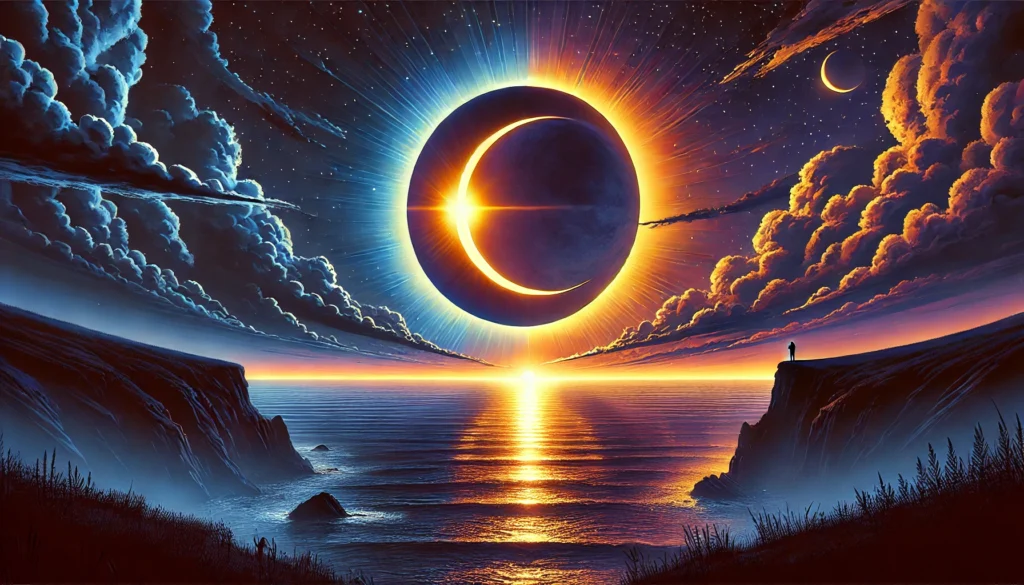Published: March 26, 2025 ✍️ By: Global World Citizen News Desk 🌍 Source: GlobalWorldCitizen.com
This Saturday, March 29, the skies will treat early risers across parts of the Northern Hemisphere to the first solar eclipse of 2025—and it’s set to be the most dramatic one of the year. But it also comes with a warning: don’t look up without proper protection.
Unlike total solar eclipses where the moon fully blocks the sun, this will be a deep partial eclipse, meaning the sun remains dangerously bright throughout the entire event. That makes it both visually stunning and potentially harmful to your eyes if viewed without certified eclipse glasses.
 Where the Eclipse Will Be Visible
Where the Eclipse Will Be Visible
This partial eclipse will stretch across a wide path of the Northern Hemisphere. Key viewing areas include:
Northeastern North America, including parts of eastern Canada and the northeastern United States (where the sun rises already partially eclipsed)
Greenland and Iceland
Western Europe
Northern Russia, where the eclipse will occur at sunset
The entire event spans nearly four hours, from 8:50 UTC to 12:43 UTC (that’s 4:50 a.m. to 8:43 a.m. EDT). Local viewing times will vary depending on location—check the Time and Date Eclipse Calculator to see what you’ll experience from your region.
 Sunrise Drama: Catch the ‘Double Sunrise’
Sunrise Drama: Catch the ‘Double Sunrise’
One of the most breathtaking moments will occur at sunrise in specific coastal areas of eastern Canada and the northeastern U.S., where the moon will already be eclipsing the sun as it appears on the horizon. This creates a “double sunrise” effect—a rare and surreal phenomenon.
From cities like Forestville, Quebec, Saint Andrews, New Brunswick, and Quoddy Head State Park, Maine, viewers will see the sun emerge as a glowing crescent, with its cusps rising separately, like two horns peeking above the ocean. The result? A fleeting “smiley face” sunrise unlike anything else in the sky.
 Where to Watch the ‘Double Sunrise’
Where to Watch the ‘Double Sunrise’
Look east! The best views will come from:
Forestville, Quebec
Saint Andrews, New Brunswick
Quoddy Head State Park, Maine (the easternmost point in the U.S.)
Choose a location with a clear view of the eastern horizon, ideally near the coast or on a high vantage point.
 Viewing and Photography Tips
Viewing and Photography Tips
Because no part of the eclipse will be total, safe solar viewing glasses or filters are required at all times. Regular sunglasses won’t cut it. For photographers, solar filters are a must to safely capture the event.
For a list of certified eclipse glasses and filters, visit the American Astronomical Society’s approved suppliers.
 Echoes of 2021
Echoes of 2021
This Saturday’s eclipse echoes a similar one on June 10, 2021, when a “ring of fire” annular eclipse passed over northern Ontario, Greenland, and Russia. Back then, much of the northeastern U.S.—including New York City, Philadelphia, and Boston—saw a dramatic partial eclipse at sunrise. The experience on March 29 will offer a nostalgic repeat for skywatchers in these regions.
 Looking Ahead
Looking Ahead
This is North America’s only solar eclipse of 2025.
The next eclipse happens on September 21, visible only from parts of the Southern Hemisphere, including Antarctica and New Zealand, where up to 73% of the sun will be covered.
Starting in 2026, the world enters an exciting eclipse era with total and annular eclipses every year through 2028.
North America’s next major event will be a partial eclipse on August 12, 2026, with totality visible in Greenland, Iceland, and Spain.
The next total solar eclipse in the U.S. won’t happen until March 30, 2033, in Alaska.

Are you planning to catch the eclipse? Tag us in your sunrise shots with #GlobalWorldCitizenEclipse!

